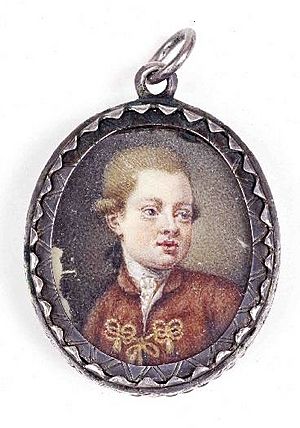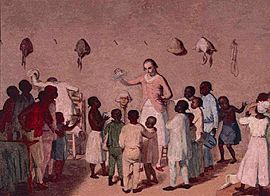Pasqual Calbó i Caldés facts for kids
Quick facts for kids
Pasqual Calbó i Caldés
|
|
|---|---|

Self-portrait, oil in ivory, display in Museu de Menorca
|
|
| Born | 24 October 1752 |
| Died | 12 April 1817 (aged 64) |
| Occupation | Painter |
| Movement | Enlightenment |
Pasqual Calbó Caldés (born October 24, 1752, died April 12, 1817) was a talented painter from the 1700s. He found lots of ideas for his art on the island of Menorca, which was a very diverse place after the British arrived.
Pasqual loved Menorca so much that he didn't care as much about making a lot of money. Because of this, he changed his job from being just a painter. He started teaching subjects like geometry, architecture, and physics.
Contents
Pasqual's Early Life and Family
Pasqual was the youngest of four children in the Calbó – Caldés family. His older siblings were Juan, Vicenta, and Antonia. His father was born in Aragón and worked in shipping, just like Pasqual's oldest brother, Juan. His mother, Anna María Caldés Orfila, was born in Menorca in 1723.
The Calbó family lived on s’Arravaleta Street. Even though they didn't have a lot of money, they let Pasqual go to school. He also took drawing and painting lessons often. These lessons were at an art school run by an Italian artist named Giuseppe Chiesa in Mahón.
Pasqual started painting when he was very young. He was much better than other students. Chiesa saw his talent and told Pasqual's parents that he should go to Italy to become an even better artist.
Calbó's Time in Menorca
Pasqual Calbó came back to his hometown, Mahón, when he was 28 years old. We don't have proof, but people think he stayed in touch with his old teacher, Chiesa.
For the next seven years, before he traveled again, Pasqual taught art. He also created many artworks, mostly portraits. These included a painting of his own family. He also painted a portrait of Count Cifuentes in 1783 for the University of Mahón.
Adventures in America
In the summer of 1787, Pasqual Calbó moved to America. There, he started painting landscapes. Early on, he drew the city and its forts. But then, he was arrested because people thought he was a spy! He had to meet the governor and was ordered to be arrested.
Luckily, the captain of his ship helped him, and he was set free two days later. After that, he asked for permission to live there as a painter, but he was told no. Then, he traveled to New Orleans. We don't know if he stayed there for long. However, we do know he moved to Santo Domingo and worked for the king of France. During this time, he painted famous works like “Dance of black people” and “Hairdressers of blacks.”
In 1790, he returned to Menorca. He stayed there for the rest of his life, continuing to paint and teach. He created a series of drawings showing the main jobs of that time. These included drawings of shellfish catchers, farmers, and stonecutters. He also put together several books for his students. These books had his own writings in Catalan, along with his drawings.
In 1812, after a busy career, Pasqual had a paralysis in both hands. This meant he could no longer paint. Five years later, he passed away at his home when he was 65 years old. He was buried in his family's tomb in the old Catholic Cemetery of Mahón.
Pasqual Calbó's Artworks
Pasqual Calbó's art hasn't always been widely known. His main teacher, Chiesa, greatly influenced his paintings and drawings. When he was in Rome, he admired the artist Mengs. Mengs's work, like "Parnaso de Villa Albani" (1779), influenced Pasqual. The wall paintings in the Hall of the Papyri in the Vatican Library also inspired him.
Three main types of art can be seen in his work:
Religious Paintings
Pasqual made two sketches for decorating an arch. These showed the Theological virtues. He also created an altarpiece for a private chapel at s’Aranjaça. This piece is now in the Ateneo de Mahón.
Landscapes
Not many of his landscape paintings have survived. But the ones we have show that he painted nature very realistically. However, his landscapes often have dull colors and gray tones. He used green colors, cloudy backgrounds, and bright human figures. This makes his work similar to that of Michele Pagano.
Portraits
Pasqual was very skilled at painting portraits. These are some of his most famous works. He painted both official portraits and private ones for people.
Important Dates in Calbó's Life
- From 1770 to 1774: He went to the Academy of Fine Arts in Venice.
- 1774: He was given a scholarship by her Imperial Highness Maria Theresa of Spain.
- From 1774 to 1778: He studied at the French Academy in Rome.
- 1778: He traveled to Vienna.
- 1779: He became the court artist in Vienna at the Imperial Gallery of Belvedere. He also started working there that same year.
- 1780: He returned to his hometown of Mahón.
- 1787: His health got worse, and he felt sadder, so he traveled to La Habana.
- 1790: Calbó left America and settled in Menorca, where he lived until he died.
After his death:
- 1866: The city council of Mahón named him an "Illustrious Son." His portrait was placed in the town hall's meeting room.
- 1912: A copy of his portrait (painted by Francesc Hernández Sanz) was placed in the gallery of famous Menorcans in the Town Hall of Mahon.
See also
 In Spanish: Pasqual Calbó Caldés para niños
In Spanish: Pasqual Calbó Caldés para niños


